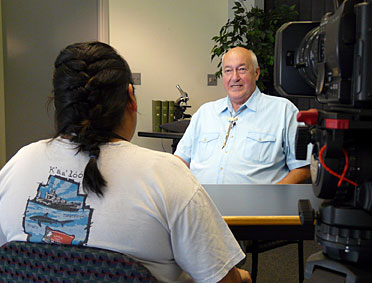You are here
A Summer Experience Researching Pacific Northwest Tribes
by Donna Turquoise
How does a Navajo veteran studying anthropology at Portland State University get the opportunity to research Pacific Northwest Indians and the Columbia River? It all started with an internship.
 Elizabeth Furse and I met to talk about Tribes and the Federal Government.Let me tell you first that I grew up along the Colorado River, a major river system that runs 1,450 miles through the Southwest. Then I served as a petty officer aboard the USS Carl Vinson before coming to Portland, Oregon. As you can see, I have always been connected with the water.
Elizabeth Furse and I met to talk about Tribes and the Federal Government.Let me tell you first that I grew up along the Colorado River, a major river system that runs 1,450 miles through the Southwest. Then I served as a petty officer aboard the USS Carl Vinson before coming to Portland, Oregon. As you can see, I have always been connected with the water.
When I applied for Center for Coastal Margin Observation & Prediction (CMOP) summer internship program, I was skeptical of being selected because my anthropology major is considered a “soft science.” Yet, they did pick me because of my strong interest in rivers and oceans. That decision started my educational discovery of the Columbia River system and the tribes alongside it.
My original project was to build on the existing tribal portal database focusing on the “four treaty tribes” and their relation to the Columbia River. The tribes are the Nez Perce Tribe, Confederated Tribes of the Umatilla Indian Reservation, Confederated Tribes of the Warm Springs Reservation of Oregon, and Confederated Tribes and Bands of the Yakama Indian Nation. It quickly became apparent that the tribal portal database is a huge project and more than one intern could accomplish in ten weeks. So my project changed to writing a scholarly paper about the relationship of the treaty tribes and the Columbia River.
The Columbia River is everything to the Pacific Northwest Indians because of the salmon. Not only are salmon important to Indians but also important to the land, animals and plants. The whole ecosystem relies on the salmon and the health of the Columbia River is very important to the salmon.
The Indians of the Columbia River are salmon people. They celebrate first salmon and first food rituals with ceremonial feasts. The salmon have provided and continue to provide subsistence, income, and balance.
As I continued my research, a large amount of the information was sad and depressing because of the ugly history with the U.S. government, religious officials, and biased non-Indian perspectives. My perspective changed when I attend a class on Indian Tribes and the Federal Government taught by Elizabeth Furse at CMOP. It was so uplifting and inspiring to learn about great tribal leaders, legal tribal history, and the government-to-government relationship.
 I conduct an interview with Roy SampselAs a visual learner, I love to do hands-on projects. CMOP gave me the opportunity to learn how to interview people. This was a challenge because I am very shy around strangers and even shyer when I am in the spotlight. I overcame that fear because my boyfriend Clyde said, “you have to do what feels important, who else is going to do it, and you have what it takes to get it done.” That support helped me get out of my shell.
I conduct an interview with Roy SampselAs a visual learner, I love to do hands-on projects. CMOP gave me the opportunity to learn how to interview people. This was a challenge because I am very shy around strangers and even shyer when I am in the spotlight. I overcame that fear because my boyfriend Clyde said, “you have to do what feels important, who else is going to do it, and you have what it takes to get it done.” That support helped me get out of my shell.
I interviewed Roy Sampsel from the Institute for Tribal Government, Elizabeth Furse founder of the Institute for Tribal Government and former US Congresswoman, and Charles Hudson from the Columbia River Inter-Tribal Fish Commission (CRITFC). When I interviewed Charles Hudson, CRITFC Public Information Office manager, I felt comfortable because I could relate with him about being an Indian outsider and also understanding the importance of water from our own backgrounds.
Charles Hudson explains how the treaty tribes protect the salmon
My interview with the Honorable Elizabeth Furse was very educational. We discussed the history of treaties and the responsibility the US government agreed to with Indian people. I found out that the US constitution mentions Indians and tribal governments have a government-to- government relationship at the Federal, State and County level. Furse said she was “glad to see me doing this work”. I felt honored.
CMOP is building a relationship with tribal governments because they acknowledge the importance of the Columbia River salmon. “The Tribes, through their water and fishing rights, play a role second to none in Columbia River management and sustainability. Not working with the Tribes would be inconsistent with our commitment to be a resource to the region. For a variety of reasons, Tribes face at the present time important challenges and opportunities. How these challenges and opportunities are addressed will shape the Pacific Northwest in general and its natural resources in particular,” said the CMOP center director, António Baptista.
The last ten weeks taught me a lot about the importance of salmon to Indian people. The Columbia River is not just a river, as I once thought, but it is everything to the Columbia River Indians. CMOP will continue to address the interests of Native Americans in the Pacific Northwest. Hopefully when I return to CMOP, I will have the opportunity to help them learn more about the tribal needs along the Columbia River and coastal margins.






